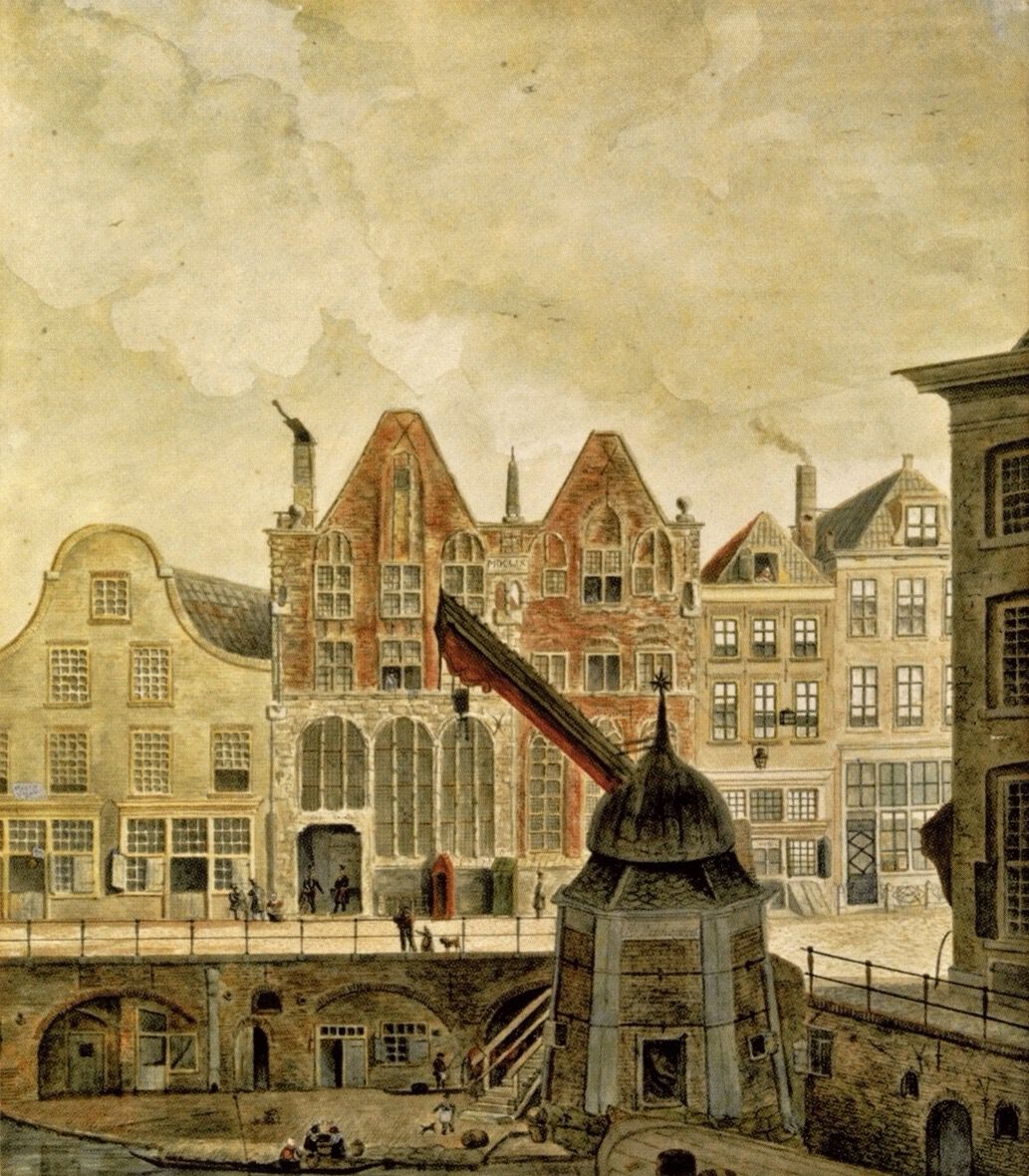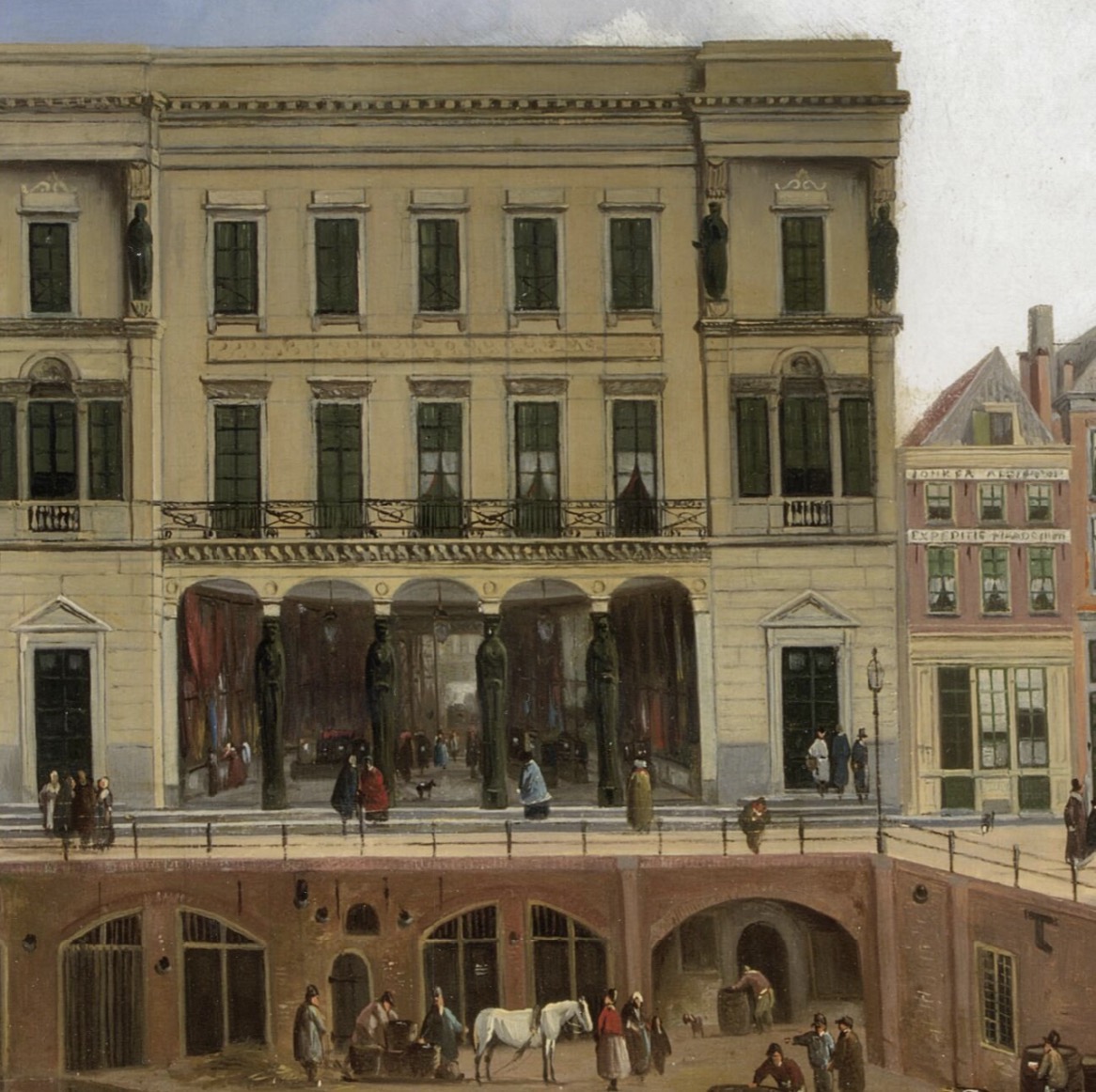Stadhuisbrug
De stadskraan bij de Stadhuisbrug
Stadhuisbrug
De stadskraan bij de Stadhuisbrug
De stadskraan stond eeuwen op deze plaats om schepen te lossen die goederen aanvoerden voor de vele markten in de stad. De boog achter de trap links van de kraan is de ingang van het – nog bestaande – wed, een schuin oplopende straat die speciaal is aangelegd om de goederen naar straatniveau te vervoeren.
Dit is een herkenbaar stadsgezicht van Utrecht, al zijn alle gebouwen die erop zijn afgebeeld sterk veranderd. Jan Hendrik Verheyen stond toen hij deze tekening maakte bij de Stadhuisbrug, aan het eind van de Massegast, een van de steegjes tussen de Steenweg en de Oudegracht. Hij keek naar de huizen aan de overkant van de Oudegracht en de stadskraan op de werf in de hoek van de Oudegracht en de Stadhuisbrug. Rechts is een gedeelte van het huis Keijserrijk te zien, een van de middeleeuwse stadskastelen aan de Oudegracht, dat al heel lang deel uitmaakt van het stadhuiscomplex. [...]
Links op de tekening staat het huis Ruitenberg, in oorsprong een middeleeuws huis dat door latere verbouwingen onherkenbaar is veranderd. Tegenwoordig is er een bioscoop in gevestigd. In het midden van de tekening is de dubbele gevel te zien van het voormalige St. Barbaraen Laurensgasthuis dat toen als militair hospitaal in gebruik was. Het rechter van deze twee huizen was het huis Kranenburg, eigendom van de priester Gijsbert Weddeloop die hier het Sint Barbaragasthuis stichtte. Later werd dit uitgebreid met het buurhuis Ter Hogerstraten. Het dubbele gasthuis werd in 1836 met enkele aangrenzende percelen aangekocht door de Amsterdamse winkelier A. Sinkel. Deze liet de bestaande bebouwing afbreken en een groot winkelpand neerzetten naar een ontwerp van de Rotterdamse architect P. Adam. In het buurhuis Ruitenberg, dat ook door Sinkel was aangekocht, bracht hij de tapijtafdeling onder. Het warenhuis ging in 1839 open. De Winkel van Sinkel, waar volgens een bekend rijmpje ‘alles te koop’ was, baarde opzien in Utrecht. Dat kwam niet alleen door de geheel nieuwe opzet van dit warenhuis, maar ook door het uiterlijk ervan. Ronduit spectaculair waren de vier kariatiden – gietijzeren zuilen in de vorm van een vrouwenfiguur – voor de ingang. Deze waren per schip uit Engeland aangevoerd en moesten door de stadskraan worden opgetakeld. Bij een van deze beelden ging het mis en brak het bovenste gedeelte van de kraan, die eeuwen lang goederen in en uit schepen had gehesen. De stadskraan is niet herbouwd. Op de plaats waar deze heeft gestaan is later een kastanjeboom geplant en de contouren van het bouwwerk zijn in het plaveisel aangegeven.
Het perceel van de Winkel van Sinkel (Oudegracht 156) werd in 1898 gekocht door de firma Vlaer en Kol die het winkelpand liet verbouwen om het als bankgebouw te kunnen gebruiken. In 1977 werd dit een vestiging van de Amro Bank waarin de Bank Vlaer en Kol was opgegaan. In 1995 kwam het in particuliere handen en werd het verbouwd tot ‘Cultureel Culinair Warenhuis’, waarbij de naam Winkel van Sinkel weer in ere werd hersteld.



